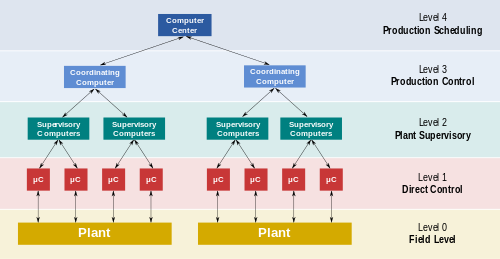監督控制
監督控制(Supervisory control)是指控制許多個別控制器或是控制迴路的控制,例如在分散控制系統中的控制。監督控制是指在較高的層次監控所有的过程控制器,不一定要針對每一個控制器的運作,不過要提供操作者整體流程的情形,而且可以整合各控制器之間的運作。
数据采集与监控系统(SCADA)就是監督控制的例子,数据采集与监控系统是特別用在過程控制中的系統,設備一般不大,可以進行像管输工艺、供水或是廢水系統的遠端操控。
形式

監督控制有二種不同的型式。一種是讓受控的機器或是程序持續運作,也可能會有操作人員隨時監控,在必要時調整控制演算法。另一種系統中的程序會接受指令,自動執行,回覆結果,然後等待新的命令。需要人工控制時,操作者可以用開關、按鈕、閥門或是控制桿來控制制動器。在早期的機器中就有這類的概念,目的是希望可以擴展人可以處理的事物量。若監督控制是自動控制,機器會適應變化的環境,並且為了一特定目的而下一些決策,例如為了維持室內溫度在一定範圍內,因此開啟或關閉室內的暖氣系統。Sheridan [1]對監督控制的定義如下:「嚴格來說,監督控制是指一個或多個人間斷性的編寫程式,持續性的從電腦獲取資訊,而電腦本身透過控制程序或是任務環境形成一個自動執行的控制迴路。」
其他特點
機器人應用以往只針對自動化控制的領域。自動化控制需要可以偵測環境所有條件的組合,並且加以處理,可以而這些條件可能代表了有驚人複雜度的問題。監督控制可以讓系統自行處理越來越多的問題,只將無法自行處理的問題留給人工來判斷。
相較於控制迴路,監督控制中的通訊延遲影響不會那麼嚴重。所有緊急的回授及處理都是在設備上進行,相對於監督控制,設備本身延遲是可忽略。因此不會有因為修改回授環而造成的不穩定。監督控制中的通訊延遲會降低操作員指定工作給設備的速度,也會讓操作員花較多時間才能確認各工作的處理情形。
相關條目
- 人因可靠度及人因工程学
- Thomas B. Sheridan:麻省理工学院研究監督控制的研究者
- 監督控制理論
參考資料:人工監督控制
- Amalberti, R. and Deblon, F (1992). Cognitive Modelling of Fighter Aircraft Process Control: A Step Towards an Intelligent On-Board Assistance System. International Journal of Man-Machine Studies, 36, 639-671.
- Hollnagel, E., Mancini, G. and Woods, D. (Eds.) (1986). Intelligent decision support in process environments. New York: Academic Press.
- Jones, P. M. and Jasek, C. A. (1997). Intelligent support for activity management (ISAM): An architecture to support distributed supervisory control. IEEE Transactions on Systems, Man, and Cybernetics, Special issue on Human Interaction in Complex Systems, Vol. 27, No. 3, May 1997, 274-288.
- Jones, P. M. and Mitchell, C. M. (1995). Human-computer cooperative problem solving: Theory, design, and evaluation of an intelligent associate system for supervisory control. IEEE Transactions on Systems, Man, and Cybernetics, 25, 7, July 1995, 1039-1053.
- Mailin, J. T., Schreckenghost, D. L., Woods, D. D., Potter, S. S., Johannsen, L., Holloway, M. and Forbus, K. D. (1991). Making intelligent systems team players: Case studies and design issues. Volume 1: Human-computer interaction design. NASA Technical Memorandum 104738, NASA Johnson Space Center.
- Mitchell, C. M. (1999). Model-based design of human interaction with complex systems. In A. P. Sage and W. B. Rouse (Eds.), Handbook of systems engineering and management (pp. 745 – 810). Wiley.
- Rasmussen, J., Pejtersen, A. and Goodstein, L. (1994). Cognitive systems engineering. New York: Wiley.
- Sarter, N. and Amalberti, R. (Eds.) (2000). Cognitive engineering in the aviation domain. Lawrence Erlbaum Associates.
- Sheridan, T. B. (1992). Telerobotics, automation, and human supervisory control. MIT Press.
- Sheridan, T. B. (2002). Humans and automation: System design and research issues. Wiley.
- Sheridan, T. B. (Ed.) (1976). Monitoring behavior and supervisory control. Springer.
- Woods, D. D. and Roth, E. M. (1988). Cognitive engineering: Human problem solving with tools. Human Factors, 30, 4, 415-430.
參考資料
- ^ Sheridan, Thomas B. Telerobotics, Automation, and Human Supervisory Control. MIT Press, Cambridge. 1992: 1. ISBN 978-0-262-19316-0.
